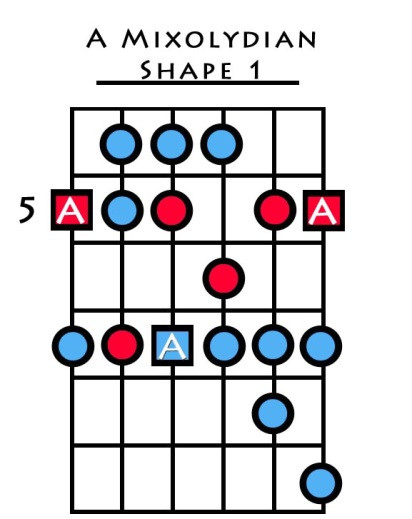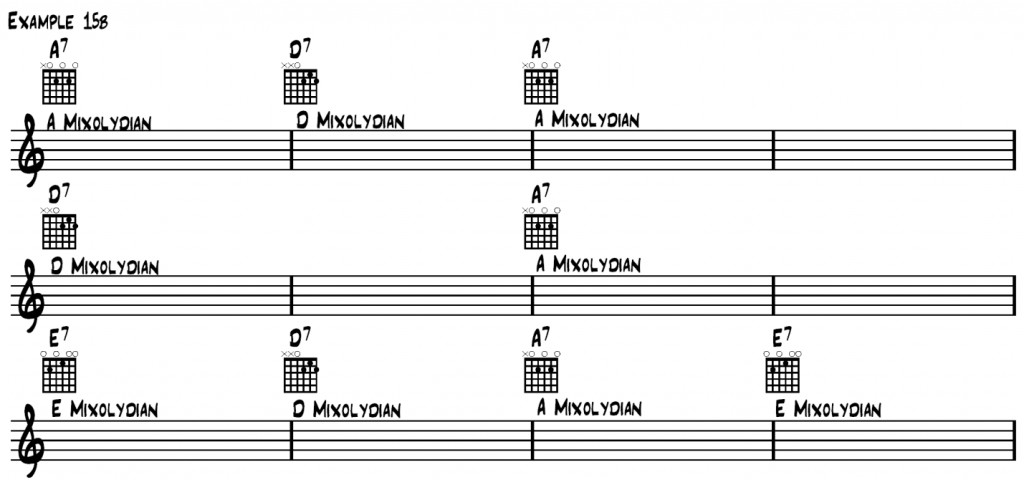Before diving deep into the Mixolydian mode for guitar, it’s beneficial to ensure you have a solid grasp of modes in general. Consider reading our primer article, How to Dissect Modes for Guitar, to build a foundational understanding.
What is the Mixolydian Scale?
The Mixolydian mode is derived from the 5th degree of the major scale and stands out as one of the most frequently used modes in contemporary guitar music. Guitarists employ it extensively for crafting both chord sequences and solos across diverse musical genres. Similar to the Lydian mode, the Mixolydian scale distinguishes itself from the major scale by just a single note. However, this subtle variation imparts a distinctly different character and feel. The Mixolydian mode is fundamental to the sound of modern blues, rock, and funk music.
You can hear the Mixolydian mode in countless popular songs, including:
- Sweet Child of Mine – Guns N’ Roses
- Sweet Home Alabama – Lynyrd Skynyrd
- Ramblin’ Man – The Allman Brothers Band
- Summer Song – Joe Satriani
- Freeway Jam – Jeff Beck
Mixolydian Formula and Guitar Diagram
The formula for the Mixolydian mode is:
1 2 3 4 5 6 b7
This formula indicates the intervals present in the scale. The ‘b7’ (flat 7th) is the crucial note that differentiates Mixolydian from the major scale, giving it a dominant, bluesy flavor.
In the key of A, the Mixolydian mode is played as follows. The diagram below visualizes the A Mixolydian mode on the guitar fretboard. Notice how the mode is centered around the Dominant 7 chord shape, highlighted in red in the diagram. This is a key relationship to understand when applying Mixolydian in a musical context.
 A Mixolydian mode guitar scale diagram in the key of A, showing the intervals 1, 2, 3, 4, 5, 6, and b7, with the dominant 7th chord highlighted in red.
A Mixolydian mode guitar scale diagram in the key of A, showing the intervals 1, 2, 3, 4, 5, 6, and b7, with the dominant 7th chord highlighted in red.
Harmonizing the Mixolydian Mode
Harmonizing the Mixolydian mode means building chords on each degree of the scale. This process generates a specific sequence of chords that are characteristic of the mode. The table below outlines the triad and seventh chord types that result from harmonizing the Mixolydian scale. Understanding these chord types is essential for writing chord progressions and solos in the Mixolydian mode.
| Degree | TRIAD Chord Type | SEVENTH Chord Types | Example in the key of A Mixolydian |
|---|---|---|---|
| I | Major | I7 (extensions 9, 11, 13) | A7 |
| ii | Minor | ii minor 7 (extensions 9, 11, b13) | Bm7 |
| iii | Minor b5 | iii minor 7b5 (extensions b9, 11, b13) | C#m7b5 |
| IV | Major | IV major 7 (extensions 9, 11, 13) | Dmaj7 |
| v | Minor | V minor 7 (extensions 9, 11, 13) | Em7 |
| vi | Minor | vi minor 7 (extensions b9, 11, b13) | F#m7 |
| bVII | Major | bVII major 7 (extensions 9, #11, 13) | Gmaj7 |
A crucial aspect of the Mixolydian mode is that the tonic chord (Chord I), when harmonized to four notes, becomes a Dominant 7th (7) chord. In traditional classical music theory, a dominant 7th chord typically implies tension that needs resolution. However, in modern music, particularly over the last century, the dominant chord has gained acceptance as a stable chord that can stand alone without immediate resolution. For instance, the initial bars of a blues progression often feature a dominant 7th chord for an extended period before moving to the IV chord, which is also frequently played as a 7th chord. The V chord in blues progressions is also commonly played as a 7th chord. This characteristic use of the dominant 7th sound is a hallmark of the Mixolydian mode in blues, rock, and related genres.
A quick way to identify a Mixolydian piece or riff is to check for the presence of a bVII major chord. If a major-sounding musical passage incorporates a bVII chord, it is very likely based on the Mixolydian mode.
Typical Mixolydian Chord Progressions
Mixolydian chord progressions often highlight the dominant 7th character of the mode and frequently feature the bVII chord. The example below illustrates a typical Mixolydian chord progression. Notice the use of I7, IV7, and the characteristic bVIImaj7 chord, creating a distinctly Mixolydian harmonic landscape.
 Example chord progression in the Mixolydian mode featuring I7, IV7, and bVIImaj7 chords, demonstrating typical Mixolydian harmony on guitar.
Example chord progression in the Mixolydian mode featuring I7, IV7, and bVIImaj7 chords, demonstrating typical Mixolydian harmony on guitar.
To further explore the Mixolydian mode and enhance your guitar playing, continue on to part 2 to discover 5 new licks and learn how to use intervals and triads to add depth and creativity to your Mixolydian mode solos and improvisations.
